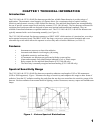
1
Figure 1 - Various Spectral Distributions
CHAPTER 1 TECHNICAL INFORMATION
Introduction
The UVU-140-A & UVU-140-AR fire detectors provide fast, reliable flame detection in a wide variety of
applications. The automatic visual integrity (vi) feature allows for a continuous check of optical surfaces,
sensitivity and electronic circuitry of the unitized fire detector. Fire and fault identification are accomplished by
the use of specific current output levels and relay contacts (UVU-140-AR only). The fire detectors are housed in
explosion-proof enclosures that are designed to meet most national and international standards. They are
available in anodized aluminum or optional stainless steel. The UVU-140-A & UVU-140-AR fire detectors are
typically mounted with a swivel mounting assembly (see Figure 3).
The UVU-140-AR unitized fire detector connects to a JBR-T-ASSY which consists of a junction box, two relays
and a terminal connector board. The JBR-T-ASSY has large, easy access, spring tension terminals and a user
selectable dip switch which allows the operator to select relay and coil status conditions (see Table 3).
Features
< Instantaneous response to ultraviolet radiation
< Automatic and manual visual integrity (vi) testing
< Adjustable sensitivity and time delay
< All automatic test functions are performed with the system on-line
< Alarm and automatic fault identification indicated by a 4 to 20mA output
< Relay outputs for fire and fault identification (UVU-140-AR only)
< The fault relay is normally energized and non-latching (UVU-140-AR only)
Spectral Sensitivity Range
The UVU-140-A & UVU-140-AR fire detectors respond to radiation wavelengths of 185 to 260 nanometres
(1850 to 2600 angstroms). Figure 1 illustrates the range of sensitivity and compares this range to other forms of
radiation. Note that UV radiation reaching the earth from the sun does not extend into the sensitivity range of the
detector. Nor does radiation from normal artificial lighting, such as fluorescent, mercury vapour and incandescent
lamps.


















